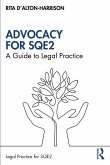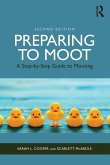The City Law School
Advocacy
The City Law School
Advocacy
- Broschiertes Buch
- Merkliste
- Auf die Merkliste
- Bewerten Bewerten
- Teilen
- Produkt teilen
- Produkterinnerung
- Produkterinnerung
The only manuals supporting students on Bar courses, providing detailed coverage of the key laws, rules and procedures alongside practical exercises.
Andere Kunden interessierten sich auch für
![Effective Written Advocacy Effective Written Advocacy]() Andrew GoodmanEffective Written Advocacy51,99 €
Andrew GoodmanEffective Written Advocacy51,99 €![Advocacy and Public Speaking: A Student's Introduction Advocacy and Public Speaking: A Student's Introduction]() Derek HalbertAdvocacy and Public Speaking: A Student's Introduction17,99 €
Derek HalbertAdvocacy and Public Speaking: A Student's Introduction17,99 €![Advocacy for SQE2 Advocacy for SQE2]() Rita D'Alton-HarrisonAdvocacy for SQE256,99 €
Rita D'Alton-HarrisonAdvocacy for SQE256,99 €![Preparing to Moot Preparing to Moot]() Sarah L. CooperPreparing to Moot47,99 €
Sarah L. CooperPreparing to Moot47,99 €![Courtroom Modifications for Child Witnesses: Law and Science in Forensic Evaluations Courtroom Modifications for Child Witnesses: Law and Science in Forensic Evaluations]() Susan R. HallCourtroom Modifications for Child Witnesses: Law and Science in Forensic Evaluations21,99 €
Susan R. HallCourtroom Modifications for Child Witnesses: Law and Science in Forensic Evaluations21,99 €![Little Afeni and the Cause for Reparations Little Afeni and the Cause for Reparations]() Nora 'Inora Kamala' WittmannLittle Afeni and the Cause for Reparations22,99 €
Nora 'Inora Kamala' WittmannLittle Afeni and the Cause for Reparations22,99 €![Advocacy: A Practical Guide Advocacy: A Practical Guide]() Peter LyonsAdvocacy: A Practical Guide32,99 €
Peter LyonsAdvocacy: A Practical Guide32,99 €-
-
-
The only manuals supporting students on Bar courses, providing detailed coverage of the key laws, rules and procedures alongside practical exercises.
Hinweis: Dieser Artikel kann nur an eine deutsche Lieferadresse ausgeliefert werden.
Hinweis: Dieser Artikel kann nur an eine deutsche Lieferadresse ausgeliefert werden.
Produktdetails
- Produktdetails
- Verlag: Oxford University Press
- 22 Revised edition
- Seitenzahl: 376
- Erscheinungstermin: 26. Juli 2024
- Englisch
- Abmessung: 206mm x 292mm x 20mm
- Gewicht: 848g
- ISBN-13: 9780198923275
- ISBN-10: 0198923279
- Artikelnr.: 70204379
- Herstellerkennzeichnung
- Libri GmbH
- Europaallee 1
- 36244 Bad Hersfeld
- gpsr@libri.de
- Verlag: Oxford University Press
- 22 Revised edition
- Seitenzahl: 376
- Erscheinungstermin: 26. Juli 2024
- Englisch
- Abmessung: 206mm x 292mm x 20mm
- Gewicht: 848g
- ISBN-13: 9780198923275
- ISBN-10: 0198923279
- Artikelnr.: 70204379
- Herstellerkennzeichnung
- Libri GmbH
- Europaallee 1
- 36244 Bad Hersfeld
- gpsr@libri.de
The manual is edited by Snigdha Nag, Barrister, Senior Lecturer, The City Law School
Part I: Introduction
1: Introduction
2: The qualities of the advocate
3: Ethics, etiquette, and cross-cultural communication in the courtoom
Part II: The Basic Components for Application and Submissions
4: Recognising competence - advocacy skills criteria
5: Preparing the court
6: The content of your application
7: Structuring your application
8: Delivering your application
9: Persuasion
Part III: Preparing for Advocacy
10: Your voice and speech
11: Memory and recall
12: Note-taking
13: Modes of address
14: The advocates as storyteller
15: The course of a trial
Part IV: Opening and Closing a Case
16: Opening speeches
17: Closing speeches
Part V: Witnesses
18: The task ahead
19: Basic components for witness handling
20: Basic questioning skills
21: Examination-in-chief
22: Cross-examination
23: Re-examination
Part IV: How-to-do-it Guides
24: Using this Part of the manual
25: Skeleton arguments
26: Default judgments
27: Summary judgments
28: Interim payments
29: Applying for an injuction
30: Applications in the Chancery Division
31: The Companies Court
32: Possession cases
33: Applying for costs in a civil case
34: Employment Tribunals
35: Remands/adjournments
36: Bail application
37: Conducting a voir dire or 'trial within a trial'
38: Making a submission of no case to answer
39: Prosecuting a plea of guilty in the Crown Court
40: The plea in mitigation
Appendix: A criminal case: R v Heath
1: Introduction
2: The qualities of the advocate
3: Ethics, etiquette, and cross-cultural communication in the courtoom
Part II: The Basic Components for Application and Submissions
4: Recognising competence - advocacy skills criteria
5: Preparing the court
6: The content of your application
7: Structuring your application
8: Delivering your application
9: Persuasion
Part III: Preparing for Advocacy
10: Your voice and speech
11: Memory and recall
12: Note-taking
13: Modes of address
14: The advocates as storyteller
15: The course of a trial
Part IV: Opening and Closing a Case
16: Opening speeches
17: Closing speeches
Part V: Witnesses
18: The task ahead
19: Basic components for witness handling
20: Basic questioning skills
21: Examination-in-chief
22: Cross-examination
23: Re-examination
Part IV: How-to-do-it Guides
24: Using this Part of the manual
25: Skeleton arguments
26: Default judgments
27: Summary judgments
28: Interim payments
29: Applying for an injuction
30: Applications in the Chancery Division
31: The Companies Court
32: Possession cases
33: Applying for costs in a civil case
34: Employment Tribunals
35: Remands/adjournments
36: Bail application
37: Conducting a voir dire or 'trial within a trial'
38: Making a submission of no case to answer
39: Prosecuting a plea of guilty in the Crown Court
40: The plea in mitigation
Appendix: A criminal case: R v Heath
Part I: Introduction
1: Introduction
2: The qualities of the advocate
3: Ethics, etiquette, and cross-cultural communication in the courtoom
Part II: The Basic Components for Application and Submissions
4: Recognising competence - advocacy skills criteria
5: Preparing the court
6: The content of your application
7: Structuring your application
8: Delivering your application
9: Persuasion
Part III: Preparing for Advocacy
10: Your voice and speech
11: Memory and recall
12: Note-taking
13: Modes of address
14: The advocates as storyteller
15: The course of a trial
Part IV: Opening and Closing a Case
16: Opening speeches
17: Closing speeches
Part V: Witnesses
18: The task ahead
19: Basic components for witness handling
20: Basic questioning skills
21: Examination-in-chief
22: Cross-examination
23: Re-examination
Part IV: How-to-do-it Guides
24: Using this Part of the manual
25: Skeleton arguments
26: Default judgments
27: Summary judgments
28: Interim payments
29: Applying for an injuction
30: Applications in the Chancery Division
31: The Companies Court
32: Possession cases
33: Applying for costs in a civil case
34: Employment Tribunals
35: Remands/adjournments
36: Bail application
37: Conducting a voir dire or 'trial within a trial'
38: Making a submission of no case to answer
39: Prosecuting a plea of guilty in the Crown Court
40: The plea in mitigation
Appendix: A criminal case: R v Heath
1: Introduction
2: The qualities of the advocate
3: Ethics, etiquette, and cross-cultural communication in the courtoom
Part II: The Basic Components for Application and Submissions
4: Recognising competence - advocacy skills criteria
5: Preparing the court
6: The content of your application
7: Structuring your application
8: Delivering your application
9: Persuasion
Part III: Preparing for Advocacy
10: Your voice and speech
11: Memory and recall
12: Note-taking
13: Modes of address
14: The advocates as storyteller
15: The course of a trial
Part IV: Opening and Closing a Case
16: Opening speeches
17: Closing speeches
Part V: Witnesses
18: The task ahead
19: Basic components for witness handling
20: Basic questioning skills
21: Examination-in-chief
22: Cross-examination
23: Re-examination
Part IV: How-to-do-it Guides
24: Using this Part of the manual
25: Skeleton arguments
26: Default judgments
27: Summary judgments
28: Interim payments
29: Applying for an injuction
30: Applications in the Chancery Division
31: The Companies Court
32: Possession cases
33: Applying for costs in a civil case
34: Employment Tribunals
35: Remands/adjournments
36: Bail application
37: Conducting a voir dire or 'trial within a trial'
38: Making a submission of no case to answer
39: Prosecuting a plea of guilty in the Crown Court
40: The plea in mitigation
Appendix: A criminal case: R v Heath








